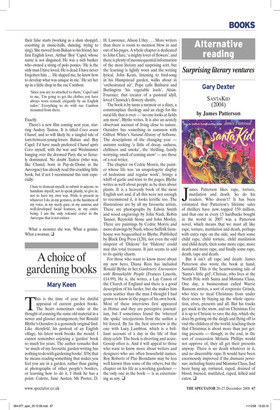A choice of gardening books
Mary Keen
This is the time of year for dutiful appraisal of current garden books. The heart sometimes sinks at the thought of conning the same old material in a newer and glossier arrangement, but Ronald Blythe’s Outsiders is a genuinely original find. Like Akenfield, his portrait of an English village, his latest work breaks the mould. I cannot remember enjoying a ‘garden’ book so much for years. The author remarks that ‘so much of my favourite garden-writing has nothing to do with gardening books’. If by that he means reading something that makes you feel you are in a garden, rather than gazing at photographs of other people’s borders, or learning how to do it, I think he has a point. Colette, Jane Austen, Mr Pooter, D. H. Lawrence, Alison Utley . . . More writers than there is room to mention blow in and out of his pages. A whole chapter is dedicated to John Clare, ‘a mighty lover of flowers’, and there is plenty of inconsequential information of the most literary and surprising sort, but the learning is lightly worn and the writing lyrical. John Keats, listening to bird-song in his Hampstead garden, walks about in ‘orchestrated air’, Pope calls Bathurst and Burlington ‘his vegetable lords’, AlainFournier, that creator of a pastoral idyll, loved Chiswick’s flowery shrubs.
The book is by turns a memoir or a diary, a commonplace theology and an elegy for the rural life that is over — ‘no one looks at fields any more’, Blythe writes. It is also an acutely observant account of living close to nature. Outsiders has something in common with Gilbert White’s Natural History of Selborne. The descriptions of the changing year — autumn reeking ‘a little of decay, sadness, chilliness and smoke’, the ‘thrilling, faintly worrying, smell of coming snow’ — are those of a real writer.
The chapter on Cedric Morris, the painter whose life was ‘an unapologetic display of hedonism and regular work’, brings a whiff of garlic and wine to the pages. Blythe writes as well about people as he does about plants. It is a heavenly book of the most English sort and, if all this were not enough to recommend it, it looks terrific too. The illustrations are by all my favourite artists. There are photographs by Edwin Smith and wood engravings by John Nash, Robin Tanner, Reynolds Stone and John Morley. There are paintings by Cedric Morris and more drawings by Nash, whose Suffolk farmhouse was bequeathed to Blythe. Published by Black Dog Press (£20), not even the odd misprint of ‘Didcote’ for ‘Hidcote’ could mar this total treasure. It just seems to add to its quirky charm.
For those who want to know more about my new hero, Diana Ross has included Ronald Bythe in her Gardeners: Encounters with Remarkable People (Frances Lincoln, £14.99). He is, she writes, a Lay Canon of the Church of England and there is a good description of his larder, but she makes him seem scattier than the man I thought I had grown to know in the pages of his own book. Most of these interviews first appeared in Hortus and they are perceptive journalism, but I sometimes found the ‘whereof she spake’ interjections from the author a bit forced. By far the best interview is the one with Lucy Lambton, which is a brilliant account of a day in the life of that dizzy celeb. The book is diverting and acute. Gossip often is. And it will appeal to those who want to know more about writers and designers who are often household names. Roy Roberts of Plas Brondanw may be less well known than some of the others, but the chapter on his life as a working gardener — the only one in the book — is as entertaining as any. ❑






















































































































 Previous page
Previous page